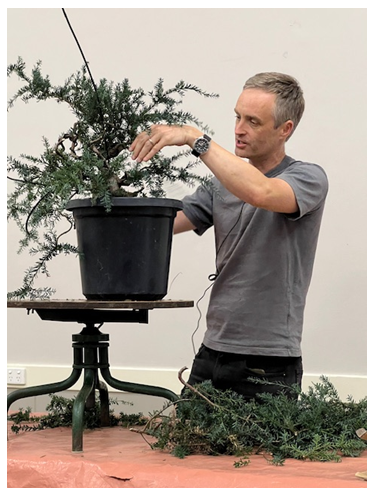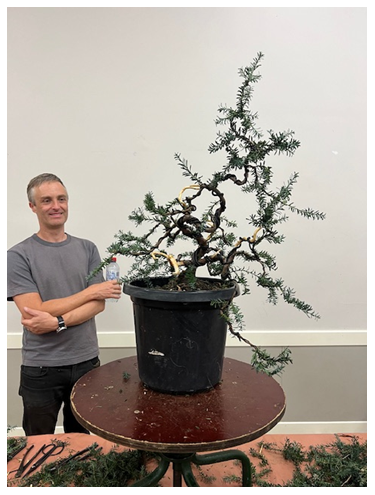At last month’s BSA meeting, Joe Morgan-Paylor from Nichigo Bonsai (https://nichigobonsai.com) used a Podocarpus lawrencei propagated by Jarryd Bailey (https://www.montanebonsai.com) in 2014 and bought from Tree Makers (https://treemakers.com.au/) recently.
Podocarpus lawrencei or the Mountain Plum Pine is a sub alpine/ alpine evergreen shrub that is widespread in the mountains of SE Australia and Tasmania at elevations of 1,100- 2,030 metres. It grows on scree slopes, rocky plateaus and ridges formed by acidic rock types like granite, where it creeps in amongst the boulders to create wind-shadow trees. The boulders provide warmth and protect the tree from the harsh elements. In higher elevations, it becomes a dwarf shrub wider than tall but in lower wet sclerophyll forests it can grow to 15 metres.
P.lawrencei is amazingly flexible and this tree was grown with multiple lines and twists to provide many branch and deadwood choices for the future and the potential to make a wildly contorted tree or a dramatic taller bonsai. It is a strong growing, elongating species that sends out runners each year and buds back well even if there is no foliage present on the branch. The internodes are very short, and it buds from most nodes.
Joe likes interesting lines and shapes, the weird and the challenging so this material was perfect! Because of the dramatic movement in the trunk, Joe picked a trunk line that both interested him and gave options. He worked back from that with the intention of extending the apex of the tree. His aim for this demonstration was to set the trunk line and establish a framework for the spring flush and the next compacting.
Joe trimmed the foliage trying to keep the turns and removed any branches that were too straight or unnecessary.

Jins were chosen and stripped and the branches and trunk line extension wired to continue the dynamic movement.
As P. lawrencei is outside its natural range in Sydney, Joe erred on the side of caution only cutting back to strong side shoots and choosing to wait for back budding in the future. As the tree had had a fairly ‘robust haircut’, to take it any further now, he felt, would set the tree back.

The next step for this tree will be compacting the branches- waiting for back budding and for those buds to strengthen before cutting back. Moderate fertilising now, will ensure strong spring growth but this will have to be managed to reduce the inter-nodal distance. When the tree shows signs of recovery, it can be repotted.

